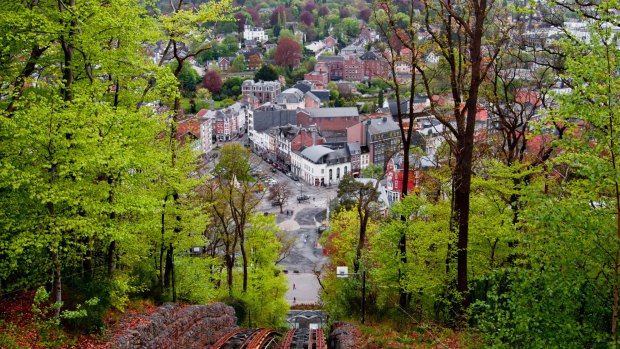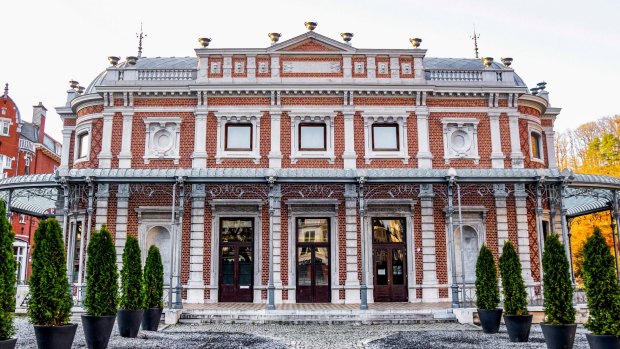This was published 5 years ago
The historic Belgian town that became a household word

Spa is lovely with its fountains and glorious trees and grandiose architecture cupped in the tranquil Ardennes hills.Credit: Alamy
In the 18th-century, Spa became so famous that its name became a generic term for any hydrotherapy resort, and later for any wellness centre. Now spas are everywhere, overcharging tourists to listen to Enya as they're slapped with seaweed and promised bliss. Big promises were made in Spa, too. The waters never cured anyone, but its visitors had much more fun than today's spa-goers as they were hoodwinked.
You could gamble, for a start. Spa claims the world's oldest casino, opened in 1763. You could attend the theatre, and gossip and flirt in assembly rooms like Jane Austen's characters. In today's spas, you politely pretend not to notice other patrons in dressing gowns. In good old Spa, nicknamed the Cafe of Europe, you hobnobbed with Emperor Joseph II, Casanova or Victor Hugo, and smoked cigars with gouty government ministers.
It all started in the 17th century, when aristocrats began travelling for pleasure and looked to the classical world for inspiration. The Greeks were keen on watery sanctuaries, and the Romans like a good wallow. Why not go to Spa? After all, a blind woman had been cured after a dip here, and local saint Remacle was known for creating springs with a stamp of his foot. Today you can see a frieze above St Remacle Church depicting the saint fending off a wolf, though not before it devoured his donkey.

Pavillon des Petits Jeux in Spa.Credit: Shutterstock
Pilgrims started visiting Spa and, where the backpackers of the day went, the well-heeled followed. In 1717, Peter the Great turned up and felt better after swigging Spa's water. You can drink from the same fountain today, fed by the town's most prolific spring. The water is slightly fizzy with notes of rust and sulphur. It tastes so awful it must be good for you. Spa's reputation was made, and royals, artists and writers came holidaying.
Head to the tourist office inside the 1880 former pump room and a nine-metre fresco shows 92 famous dyspeptic visitors in crinolines and frock coats. It doesn't show Casanova or Liszt, though, whose lives were too scandalous. Or Turner, who painted some pretty scenes of Spa but was considered a mere amateur by the sniffy continentals.
It was English visitors who took the term "spa" back to England and applied it to various spring resorts. The Anglican church and large English colony have vanished, but there's something rather English about Spa's villas, leafy promenades and landscaped parks dotted with statues and rotundas. The 1758 Parc des Sept Heures is beautiful beneath groves of chestnut trees, bracketed by two dainty spa pavilions connected by a rusting cast-iron walkway where patients once perambulated.
Spa has many fine neoclassical buildings, most in need of a cure themselves. Spa lost its mojo in the 20th century as society lost faith in mineral waters. Wars put visitors off. The Kaiser was headquartered in Spa during World War I, and the US First Army had a command post here in World War II.
Spa is lovely though, with its fountains and glorious trees and grandiose architecture cupped in the tranquil Ardennes hills. The casino is still going. The magnificent former bathhouse beside it is abandoned, but being considered for World Heritage listing. The town has good cafes and restaurants and a calendar of music festivals. Spa-Francorchamps circuit hosts Formula One races.
A modern spa centre sits on the hillside above town. The Thermes de Spa features huge swimming pools of warm mineral water, as well as Turkish baths and steam baths. You don't need to listen to Enya or be rubbed with cucumber. You just wallow the afternoon away in the outdoor pools, your shoulders pummelled by water jets, as you gaze out over Spa, a forgotten corner of Europe with a fabulous past.
TRIP NOTES
Brian Johnston travelled courtesy of Visit Wallonia.
MORE
FLY
Cathay Pacific flies daily from Melbourne and Sydney to Brussels via Hong Kong. See cathaypacific.com
STAY
Boutique hotel La Tonellerie sits on the Parc des Sept Heures and is quiet and comfortable, with a terrace restaurant featuring finger-licking Mediterranean cuisine. Rooms from $150. See latonnellerie.be
Sign up for the Traveller Deals newsletter
Get exclusive travel deals delivered straight to your inbox. Sign up now.